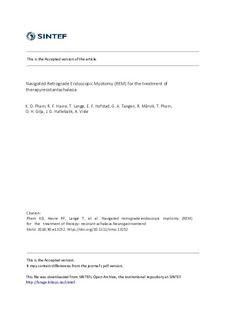| dc.contributor.author | Pham, Khanh Do-Cong | |
| dc.contributor.author | Havre, Roald Flesland | |
| dc.contributor.author | Langø, Thomas | |
| dc.contributor.author | Hofstad, Erlend Fagertun | |
| dc.contributor.author | Tangen, Geir Arne | |
| dc.contributor.author | Mårvik, Ronald | |
| dc.contributor.author | Pham, T. | |
| dc.contributor.author | Gilja, Odd Helge | |
| dc.contributor.author | Hatlebakk, Jan Gunnar | |
| dc.contributor.author | Viste, Asgaut | |
| dc.date.accessioned | 2018-12-05T08:24:20Z | |
| dc.date.available | 2018-12-05T08:24:20Z | |
| dc.date.created | 2018-06-02T13:52:08Z | |
| dc.date.issued | 2018 | |
| dc.identifier.citation | Neurogastroenterology and Motility. 2018, 30 (4), pp 6 | nb_NO |
| dc.identifier.issn | 1350-1925 | |
| dc.identifier.uri | http://hdl.handle.net/11250/2576077 | |
| dc.description.abstract | Background In achalasia, muscle spasm may involve the proximal esophagus. When the muscle spasm is located in the proximal esophagus, conventional per oral endoscopic myotomy (POEM) may not be sufficient to relieve symptoms. In this paper, we describe retrograde endoscopic myotomy (REM) as a novel approach to perform myotomy of the proximal esophagus, with the application of a navigation tool for anatomical guidance during REM. We aim to evaluate the feasibility and safety of REM and usefulness of the navigation during REM. Method A 42‐year‐old male with type III achalasia who was treated with laparoscopic myotomy with fundoplication, multiple pneumatic balloon dilations, Botox injections and anterior POEM of the middle and distal esophagus without symptomatic effect. Repeated high‐resolution‐ manometry (HRM) revealed occluding contractions of high amplitude around and above the aortic arch. A probe‐based real‐time electromagnetic navigation platform was used to facilitate real‐time anatomical orientation and to evaluate myotomy position and length during REM. Results The navigation system aided in identifying the major structures of the mediastinum, and position and length of the myotomy. Twelve weeks after REM, the Eckardt score fell from seven at baseline seven to two. We also observed improvement with reduction of the pressure at the level of previous spasms in the proximal esophagus from 124 mmHg to 8 mmHg on HRM. Conclusion REM makes the proximal esophagus accessible for endoscopic myotomy. Potential indication for REM is motility disorders in the proximal esophagus and therapy failure after POEM. | nb_NO |
| dc.description.abstract | Navigated retrograde endoscopic myotomy (REM) for the treatment of therapy-resistant achalasia | nb_NO |
| dc.language.iso | eng | nb_NO |
| dc.title | Navigated retrograde endoscopic myotomy (REM) for the treatment of therapy-resistant achalasia | nb_NO |
| dc.type | Journal article | nb_NO |
| dc.type | Peer reviewed | nb_NO |
| dc.description.version | acceptedVersion | nb_NO |
| dc.source.pagenumber | 6 | nb_NO |
| dc.source.volume | 30 | nb_NO |
| dc.source.journal | Neurogastroenterology and Motility | nb_NO |
| dc.source.issue | 4 | nb_NO |
| dc.identifier.doi | 10.1111/nmo.13252 | |
| dc.identifier.cristin | 1588483 | |
| cristin.unitcode | 7401,90,25,0 | |
| cristin.unitname | Helse | |
| cristin.ispublished | true | |
| cristin.fulltext | postprint | |
| cristin.qualitycode | 1 | |
